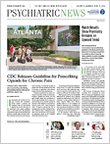A young woman who lived alone in a third floor apartment stepped out of her shower one morning and confronted a stranger with a knife. He tied her hands and began to loot the apartment. She believed he would rape and then kill her.
While he ransacked another room, she managed to open a window and jump. As she fell, she saw a pink parachute snap open above her, and beneath its large, life-saving canopy, she felt herself float slowly to the ground. There was, of course, no parachute, and her descent lasted only seconds. Although shrubbery broke her fall, she fractured her wrist and her pelvis. Passersby called an ambulance, and the police arrested the invader, still in her apartment.
When seen eight months later, with her physical injuries healed, she related these events with an ironic smile in a calm, straightforward manner. She had the satisfaction of having testified at the man’s trial and seeing him sentenced to prison, and had then resumed her life without further difficulties.
After her horrific experience, posttraumatic stress disorder (PTSD) seemed predictable, but it did not occur. Why not? Did her fabrication of a protective image, the pink parachute, change the emotional environment despite the threat of injury or death? Did “self-hypnosis” or “dissociation” allow her to wall off the perception of mortal threat and to substitute a benign reality? Perhaps PTSD failed to develop because, arguably, the “traumatic stress” was disguised and rendered harmless.
Hypnosis was introduced to medicine over 200 years ago by Franz Mesmer, although the “power of suggestion” predates him and was probably used in healing rituals by shamans in Middle Paleolithic caves. Mesmer’s “animal magnetism” appeared to cure psychic afflictions, but mesmerism and its practitioners were discredited in 1784 by a prestigious Royal Commission that could find no physical basis for it.
Dissociation also has a long, somewhat ambiguous, history, in part because of its association with hypnosis. In the late 19th and early 20th Centuries, hysteria was the prevailing psychiatric illness, the primary heuristic focus of Pierre Janet, Jean-Martin Charcot, and others at the SalpêtriȲre in Paris and of Sigmund Freud and his group in Vienna. Both Janet and Freud treated hysteria with hypnosis. Janet believed hysteria represented an attempt at psychological healing after trauma. Freud thought it arose from unconscious conflict. At present, the evidence seems to favor Janet.
Today, a group of disorders replaces the umbrella category of “hysteria.” They share prominent dissociative elements and include conversion and somatic symptom disorders, borderline personality, fugue states, dissociative identity disorder, and PTSD. Dissociative and traumatic stress disorders are placed into separate diagnostic categories in DSM-5, but this division is clinically misleading. (Elsewhere, for example, I have combined them into a single category to facilitate the formulation process that underlies treatment planning.)
Hypnosis has been used, sometimes widely and sometimes sparingly, as a treatment for the dissociative disorders and for PTSD. In recent history, respected psychiatrists, like Milton Erickson, blended it effectively with psychotherapy, and others, like Martin Orne, debunked it; for example, Orne showed it could be misused to plant false memories. Hypnosis still carries the stigma of quackery and stage entertainment, so that its modest but real benefits are obscured. It is simple to learn and easy to use. Because of its unsavory tinge, and because “anybody” can use it, psychotherapists may not include it in their therapeutic armamentaria, or, if they do, they might keep quiet about it.
Dissociation itself can be conceptualized as a hypnotic state generated internally in response to real or threatened injury. It is a psychic Band-Aid that seals over and protects but may not reverse the damage. In cases that might be expected to lead to posttraumatic stress, a self-generated hypnotic response, like the jumper’s pink parachute, may prevent or render unnecessary the development of PTSD.
Hypnotic suggestion in the hands of a willing psychotherapist may be equally effective. Dissociative disorders are among the most difficult psychiatric conditions to resolve: could it be time to reexamine the role of this “low-tech” tool and return hypnosis to the rank of first-line treatments? ■

